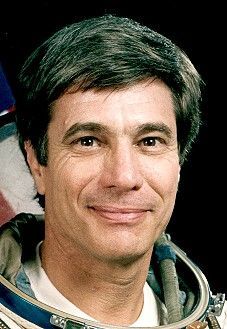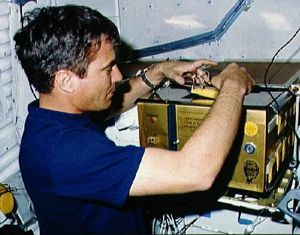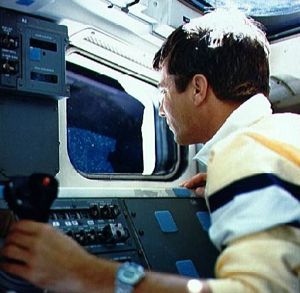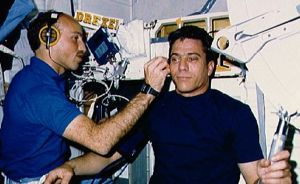
Home - Search - Browse - Alphabetic Index: 0- 1- 2- 3- 4- 5- 6- 7- 8- 9
A- B- C- D- E- F- G- H- I- J- K- L- M- N- O- P- Q- R- S- T- U- V- W- X- Y- Z
Blaha, John Elmer
 Blaha Credit: www.spacefacts.de |
Status: Inactive; Active 1980-1997. Born: 1942-08-26. Spaceflights: 5 . Total time in space: 161.11 days. Birth Place: San Antonio, Texas.
Official NASA Biography as of June 2016:JOHN E. BLAHA (COLONEL, USAF, RET.)
NASA ASTRONAUT (FORMER)
PERSONAL DATA: Born August 26, 1942, in San Antonio, Texas. Married to the former Brenda I. Walters of St. Louis, Missouri. They have three grown children and two grandchildren.
EDUCATION: Graduated from Granby High School in Norfolk, Virginia, in 1960; received a bachelor of science in engineering science from the United States Air Force Academy in 1965 and a master of science in astronautical engineering from Purdue University in 1966.
ORGANIZATIONS: Association of Space Explorers; Purdue Alumni Association; Society of Experimental Test Pilots; Air Force Academy Association of Graduates; Chairman, Board of Directors Brooks Aerospace Foundation.
SPECIAL HONORS: Inducted into the Astronaut Hall of Fame, Russian Order of Friendship Medal, 2 NASA Distinguished Service Medals, NASA Outstanding Leadership Medal, NASA Exceptional Service Medal, 5 NASA Space Flight Medals, Countdown Magazine Outstanding Astronaut of 1991, Defense Superior Service Medal, Legion of Merit, 2 Air Force Distinguished Flying Crosses, Defense Meritorious Service Medal, 3 Meritorious Service Medals, 18 Air Medals, Air Force Commendation Medal, the British Royal Air Force Cross, the Vietnam Cross of Gallantry, Purdue Outstanding Aerospace Engineer Award, and the Purdue Engineering Alumnus Award. Outstanding Pilot, F-4 Combat Crew Training. Outstanding Junior Officer of the Year, 3rd Tactical Fighter Wing. Distinguished Graduate Air Force Test Pilot School. Distinguished Graduate Air Command and Staff College. University Roundtable Annual Best and Brightest Award. Honorary Grand Marshall Fiesta Flambeau Parade. Honorary Grand Marshall Battle of Flowers Parade. Granby High School Hall of Fame. Planet Blaha named in his honor by the International Astronomical Union and Smithsonian Astrophysical Observatory.
AIR FORCE EXPERIENCE: Blaha received his pilot wings at Williams Air Force Base, Arizona, in 1967. He was subsequently assigned as an operational pilot flying F-4, F-102, F-106, and A-37 aircraft (completing 361 combat missions in Vietnam). He attended the USAF Aerospace Research Pilot School at Edwards Air Force Base, California, in 1971, and piloted the NF-104 research aircraft to 104,400 feet. Following graduation, he served as an F-104 instructor pilot at the test pilot school, teaching low lift-to-drag approach, zoom, performance, stability/control, and spin flight test techniques. In 1973, he was assigned as a test pilot working with the Royal Air Force at the Aeroplane and Armament Experimental Establishment, Boscombe Down, United Kingdom. During a 3-year tour, he flew stability/control, performance, spin, and weapons delivery flight tests in the Jaguar, Buccaneer, Hawk, and Jet Provost aircraft. In 1976 he attended the USAF Air Command and Staff College. After graduation, he was assigned to work for the Assistant Chief of Staff, Studies and Analyses, at Headquarters USAF in the Pentagon. During this tour, he presented F-15 and F-16 study results to Department of Defense, State Department, and congressional staffs.
NASA EXPERIENCE: Selected as an astronaut in May 1980, Blaha has logged 161 days in space on 5 space missions. He served as pilot on STS-33 and STS 29, was Spacecraft Commander on STS-58 and STS-43, served on Mir-22 as Board Engineer 2, and was a Mission Specialist on STS-79 and STS-81.
In addition to flying 5 space missions, Blaha has served as the Chairman, NASA Space Flight Safety Panel; Weather Manager, Mission Management Team; lead spacecraft communicator; member, NASA Space Shuttle Improvement Panel. Blaha also led the design, development, and integration of the Orbiter Head Up Display system. Additionally, he led the development of contingency abort procedures which significantly improve crew survivability in the event of multiple main engine failures during ascent. He has logged more than 7,000 hours of flying time in 34 different aircraft, and has written numerous technical articles on spacecraft performance and control.
John Blaha retired from NASA in September 1997 to return to his hometown of San Antonio, Texas, where he joined the Executive Management Group of the United Services Automobile Association
SPACE FLIGHT EXPERIENCE: STS-29 Discovery launched from Kennedy Space Center, Florida, on March 13, 1989, and landed at Edwards Air Force Base on March 18, 1989. During this very successful mission the five-man crew aboard Shuttle Discovery deployed the East Tracking and Data Relay Satellite, and performed eight scientific/medical experiments.
STS-33 Discovery (November 22-27, 1989). Launched at night, this five-day mission carried Department of Defense payloads and other secondary payloads. After 79 orbits of the Earth, this highly successful mission concluded with a hard surface landing on Runway 4 at Edwards Air Force Base, California.
STS-43 Atlantis (August 2-11, 1991) launched from the Kennedy Space Center carrying a five person crew. During the nine-day mission the crew deployed the West Tracking and Data Relay Satellite, and conducted 32 physical, material, and life science experiments that supported the development of the Extended Duration Orbiter and Space Station. After 142 orbits of the Earth, this very significant mission concluded with a landing on Runway 15 at the Kennedy Space Center, Florida.
STS-58 Columbia (October 18 to November 1, 1993) launched from the Kennedy Space Center carrying a seven-person crew. This record duration fourteen-day life science research mission has been recognized by NASA management as the most successful and efficient Spacelab flight that NASA has flown. The crew performed neurovestibular, cardiovascular, cardiopulmonary, metabolic, and musculoskeletal medical experiments on themselves and 48 rats, expanding our knowledge of human and animal physiology both on earth and in space flight. In addition, the crew performed 16 engineering tests aboard the Orbiter Columbia and 20 Extended Duration Orbiter Medical Project experiments. Landing was at Edwards Air Force Base on Runway 22.
Blaha began Russian language training in August 1994 at the Defense Language Institute in Monterey, California, and commenced an intensive training program at the Cosmonaut Training Center, Star City, Russia in January 1995. He launched on STS-79 on September 16, 1996. After docking he transferred to the Mir Space Station. Assigned as a Board Engineer 2, he spent the following 4 months with the Mir 22 Cosmonaut crew conducting material science, fluid science, and life science research. Blaha returned to earth aboard STS-81 on January 22, 1997.
MAY 2008
This is the only version available from NASA. Updates must be sought direct from the above named individual.
Official NASA Biography - 1997
- NAME: John E. Blaha (Colonel, USAF, Ret.)
- NASA Astronaut
- PERSONAL DATA:
- Born August 26, 1942, in San Antonio, Texas. Married to the former Brenda I. Walters of St. Louis, Missouri. They have three grown children and two grandchildren. He enjoys exercise and tennis.
- EDUCATION:
- Graduated from Granby High School in Norfolk, Virginia, in 1960; received a bachelor of science in engineering science from the United States Air Force Academy in 1965 and a master of science in astronautical engineering from Purdue University in 1966.
- ORGANIZATIONS:
- Member Board of Directors, Association of Space Explorers, Purdue Alumni Association, Society of Experimental Test Pilots, Air Force Academy Association of Graduates.
- SPECIAL HONORS:
- NASA Distinguished Service Medal, NASA Outstanding Leadership Medal, NASA Exceptional Service Medal, 4 NASA Space Flight Medals, Countdown Magazine Outstanding Astronaut of 1991, Defense Superior Service medal, Legion of Merit, 2 Air Force Distinguished Flying Crosses, Defense Meritorious Service Medal, 3 Meritorious Service Medals, 18 Air Medals, Air Force Commendation Medal, the British Royal Air Force Cross, the Vietnam Cross of Gallantry, and the Purdue Engineering Alumnus Award. Outstanding Pilot, F-4 Combat Crew Training. Outstanding Junior Officer of the Year, 3rd Tactical Fighter Wing. Distinguished Graduate Air Force Test Pilot School. Distinguished Graduate Air Command and Staff College.
- NASA EXPERIENCE:
- Selected as an astronaut in May 1980, Blaha has logged 161 days in space on 5 space missions: Commander STS-58, Commander STS-43, Pilot STS-33 and STS-29, and Board Engineer 2 Mir-22. He has logged more than 7,000 hours of flying time in 34 different aircraft, and has written numerous technical articles on spacecraft performance and control.
On his first space mission Blaha was the STS-29 pilot. The five-man crew launched on the Space Shuttle Discovery on March 13, 1989, and landed at Edwards Air Force Base on March 18, 1989. During this very successful mission the crew deployed the East Tracking and Data Relay Satellite, and performed eight scientific/medical experiments.
Blaha also was the pilot on the crew of STS-33 which launched at night from Kennedy Space Center, Florida, on November 22, 1989, aboard the Space Shuttle Discovery. The five-day mission carried Department of Defense payloads and other secondary payloads. After 79 orbits of the Earth, this highly successful mission concluded on November 27, 1989, with a hard surface landing on Runway 4 at Edwards Air Force Base, California.
On STS-43 Blaha commanded a five-person crew aboard the Orbiter Atlantis. The nine-day mission launched from the Kennedy Space Center on August 2, 1991. During the flight crew members deployed the West Tracking and Data Relay Satellite, and conducted 32 physical, material, and life science experiments that supported the development of the Extended Duration Orbiter and Space Station. After 142 orbits of the Earth, this very significant mission concluded with a landing on Runway 15 at the Kennedy Space Center on August 11, 1991.
On STS-58 Blaha commanded a seven-person life science research mission aboard the Space Shuttle Columbia, launching from the Kennedy Space Center on October 18, 1993, and landing at Edwards Air Force Base on Runway 22 on November 1, 1993. This record duration fourteen-day Space Shuttle mission has been recognized by NASA management as the most successful and efficient Spacelab flight that NASA has flown. The crew performed neurovestibular, cardiovascular, cardiopulmonary, metabolic, and musculoskeletal medical experiments on themselves and 48 rats, expanding our knowledge of human and animal physiology both on earth and in space flight. In addition, the crew performed 16 engineering tests aboard the Orbiter Columbia and 20 Extended Duration Orbiter Medical Project experiments.
Blaha began Russian language training in August 1994 at the Defense Language Institute in Monterey, California, and commenced an intensive training program at the Cosmonaut Training Center, Star City, Russia in January 1995. He launched on STS-79 on September 16, 1996. After docking he transferred to the Mir Space Station. Assigned as a Board Engineer 2, he spent the following 4 months with the Mir 22 Cosmonaut crew conducting material science, fluid science, and life science research. Blaha returned to earth aboard STS-81 on January 22, 1997.
- AIR FORCE EXPERIENCE:
- Blaha received his pilot wings at Williams Air Force Base, Arizona, in 1967. He was subsequently assigned as an operational pilot flying F-4, F-102, F-106, and A-37 aircraft (completing 361 combat missions in Vietnam).
He attended the USAF Aerospace Research Pilot School at Edwards Air Force Base, California, in 1971, and piloted the NF-104 research aircraft to 104,400 feet. Following graduation, he served as an F-104 instructor pilot at the test pilot school, teaching low lift-to-drag approach, zoom, performance, stability/control, and spin flight test techniques.
In 1973, he was assigned as a test pilot working with the Royal Air Force at the Aeroplane and Armament Experimental Establishment, Boscombe Down, United Kingdom. During a 3-year tour, he flew stability/control, performance, spin, and weapons delivery flight tests in the Jaguar, Buccaneer, Hawk, and Jet Provost aircraft.
In 1976 he attended the USAF Air Command and Staff College. After graduation, he was assigned to work for the Assistant Chief of Staff, Studies and Analyses, at Headquarters USAF in the Pentagon. During this tour, he presented F-15 and F-16 study results to Department of Defense, State Department, and congressional staffs.
More at: Blaha.
Family: Astronaut. Country: USA. Spacecraft: Mir. Flights: STS-61-H, STS-29, STS-33, STS-43, STS-58, STS-76 Mir NASA-1, STS-79 Mir NASA-2, STS-81, STS-81 Mir NASA-3. Projects: STS. Agency: USAF. Bibliography: 12, 5172.
 | STS-29 STS-29 Pilot Blaha with SE83-9 "Chix in Space" incubator on OV-103's middeck Credit: NASA |
 | STS-33 STS-33 Pilot Blaha with his hand on the RHC looks out aft flight deck window Credit: NASA |
 | STS-29 STS-29 Pilot Blaha has blood flow checked by MS Bagian on OV-103's middeck Credit: NASA |
1942 August 26 - .
- Birth of John Elmer Blaha - . Nation: USA. Related Persons: Blaha. American test pilot astronaut 1980-1997. Flew 361 combat missions in Vietnam. 5 spaceflights, 161.1 days in space. Flew to orbit on STS-29 (1989), STS-33, STS-43, STS-58, STS-79..
1980 May 19 - .
- NASA Astronaut Training Group 9 selected. - .
Nation: USA.
Related Persons: Bagian,
Blaha,
Bolden,
Bridges,
Chang-Diaz,
Cleave,
Dunbar,
Fisher, William,
Gardner, Guy,
Grabe,
Hilmers,
Leestma,
Lounge,
O Connor,
Richards,
Ross,
Smith,
Spring,
Springer.
The group was selected to provide pilot, engineer, and scientist astronauts for space shuttle flights.. Qualifications: Pilots: Bachelor's degree in engineering, biological science, physical science or mathematics. Advanced degree desirable. At least 1,000 flight-hours of pilot-in-command time. Flight test experience desirable. Excellent health. Vision minimum 20/50 uncorrected, correctable to 20/20 vision; maximum sitting blood pressure 140/90. Height between 163 and 193 cm.
Mission Specialists: Bachelor's degree in engineering, biological science, physical science or mathematics and minimum three years of related experience or an advanced degree. Vision minimum 20/150 uncorrected, correctable to 20/20. Maximum sitting blood pressure of 140/90. Height between 150 and 193 cm..
1986 June - .
- STS-61-H (cancelled) - . Crew: Blaha, Buchli, Coats, Fisher, Springer, Sudarmono, Wood, Nigel. Backup Crew: Akbar, Farrimond. Payload: Communications satellites. Nation: USA. Program: STS. Flight: STS-61-H. Spacecraft Bus: Shuttle. Spacecraft: Columbia. Planned shuttle mission for deployment of commercial communications satellites. Cancelled after Challenger disaster. .
1989 March 13 - . 14:57 GMT - . Launch Site: Cape Canaveral. Launch Complex: Cape Canaveral LC39B. Launch Platform: MLP2. LV Family: Shuttle. Launch Vehicle: Space Shuttle.
- STS-29 - .
Call Sign: Discovery. Crew: Bagian,
Blaha,
Buchli,
Coats,
Springer.
Payload: Discovery F08 / SHARE. Mass: 17,280 kg (38,090 lb). Nation: USA.
Related Persons: Bagian,
Blaha,
Buchli,
Coats,
Springer.
Agency: NASA Houston.
Program: STS.
Class: Manned.
Type: Manned spaceplane. Flight: STS-29.
Spacecraft Bus: Shuttle.
Spacecraft: Discovery.
Duration: 4.99 days. Decay Date: 1989-03-18 . USAF Sat Cat: 19882 . COSPAR: 1989-021A. Apogee: 308 km (191 mi). Perigee: 297 km (184 mi). Inclination: 28.50 deg. Period: 90.60 min.
Manned five crew. Deployed TDRS 4. Payloads: Deploy IUS (Inertial Upper Stage) with Tracking and Data Relay Satellite (TDRS)-D. Protein Crystal Growth (PCG); Chromosome and Plant Cell Division in Space; IMAX 70mm camera; Shuttle Student Involvement Project (SSIP) experiments: SSIP 82-8, Effects of Weightlessness in Space Flight on the Healing of Bone Fractures, and SSIP 83-9, Chicken Embryo Development in Space; Air Force Maui Optical Site (AMOS) experiment.
1989 March 18 - .
- Landing of STS-29 - . Return Crew: Bagian, Blaha, Buchli, Coats, Springer. Nation: USA. Related Persons: Bagian, Blaha, Buchli, Coats, Springer. Program: STS. Flight: STS-29. STS-29 landed at 14:31 GMT. .
1989 November 23 - . 00:23 GMT - . Launch Site: Cape Canaveral. Launch Complex: Cape Canaveral LC39B. Launch Platform: MLP2. LV Family: Shuttle. Launch Vehicle: Space Shuttle.
- STS-33 - .
Call Sign: Discovery. Crew: Blaha,
Carter,
Gregory,
Musgrave,
Thornton.
Payload: Discovery F09 / Magnum 2 [IUS]. Mass: 116,884 kg (257,685 lb). Nation: USA.
Related Persons: Blaha,
Carter,
Gregory,
Musgrave,
Thornton.
Agency: NASA Houston.
Program: STS.
Class: Manned.
Type: Manned spaceplane. Flight: STS-33.
Spacecraft Bus: Shuttle.
Spacecraft: Discovery.
Duration: 5.00 days. Decay Date: 1989-11-28 . USAF Sat Cat: 20329 . COSPAR: 1989-090A. Apogee: 214 km (132 mi). Perigee: 207 km (128 mi). Inclination: 28.50 deg. Period: 88.70 min.
Manned five crew. Deployed a classified payload. Orbits of Earth: 78. Distance traveled: 3,218,687 km. Landed at: Concrete runway 04 at Edwards Air Force Base, Cali. Landing Speed: 368 kph. Touchdown miss distance: 570.00 m. Landing Rollout: 2,366.00 m. Payloads: DoD Mission - third space shuttle night launch.
1989 November 28 - .
- Landing of STS-33 - . Return Crew: Blaha, Carter, Gregory, Musgrave, Thornton. Nation: USA. Related Persons: Blaha, Carter, Gregory, Musgrave, Thornton. Program: STS. Flight: STS-33. STS-33 landed at 00:35 GMT. .
1991 August 2 - . 15:02 GMT - . Launch Site: Cape Canaveral. Launch Complex: Cape Canaveral LC39A. Launch Platform: MLP1. LV Family: Shuttle. Launch Vehicle: Space Shuttle.
- STS-43 - .
Call Sign: Atlantis. Crew: Adamson,
Baker, Mike,
Blaha,
Low,
Lucid.
Payload: Atlantis F09 / TDRS 5 [IUS]. Mass: 21,265 kg (46,881 lb). Nation: USA.
Related Persons: Adamson,
Baker, Mike,
Blaha,
Low,
Lucid.
Agency: NASA Houston.
Program: STS.
Class: Manned.
Type: Manned spaceplane. Flight: STS-43.
Spacecraft Bus: Shuttle.
Spacecraft: Atlantis.
Duration: 8.89 days. Decay Date: 1991-08-11 . USAF Sat Cat: 21638 . COSPAR: 1991-054A. Apogee: 306 km (190 mi). Perigee: 301 km (187 mi). Inclination: 28.50 deg. Period: 90.60 min.
Manned five crew. Deployed TDRS 5 satellite. Payloads: Tracking and Data Relay Satellite (TDRS)-E/lnertial Upper Stage (lUS), Space Station Heatpipe Advanced Radiator Element (SHARE)-ll, Shuttle Solar Backscatter Ultraviolet (SSBUV) instrument 03, Optical Communications Through the Shuttle Window (OCTW), Air Force Maui Optical Site (AMOS) Calibration Test, Auroral Photography Experiment (APE)-B, Bioserve-lnstrumentation Technology Associates Materials Dispersion Apparatus (BlMDA)-02, Investigations Into Polymer Membrane Processing (IPMP)-03, Protein Crystal Growth Ill Block Il, Space Acceleration Measure-ment System (SAMS), Solid Surface Combustion Experiment (SSCE)-02, Tank Pressure Control Experiment (TPCE).
1991 August 11 - .
- Landing of STS-43 - . Return Crew: Adamson, Baker, Mike, Blaha, Low, Lucid. Nation: USA. Related Persons: Adamson, Baker, Mike, Blaha, Low, Lucid. Program: STS. Flight: STS-43. STS-43 landed at 12:28 GMT. .
1993 October 18 - . 14:53 GMT - . Launch Site: Cape Canaveral. Launch Complex: Cape Canaveral LC39B. Launch Platform: MLP1. LV Family: Shuttle. Launch Vehicle: Space Shuttle.
- STS-58 - . Call Sign: Columbia. Crew: Blaha, Fettman, Lucid, McArthur, Searfoss, Seddon, Wolf. Payload: Columbia F15 / EDO. Mass: 10,517 kg (23,186 lb). Nation: USA. Related Persons: Blaha, Fettman, Lucid, McArthur, Searfoss, Seddon, Wolf. Agency: NASA Houston. Program: STS. Class: Manned. Type: Manned spaceplane. Flight: STS-58. Spacecraft Bus: Shuttle. Spacecraft: Columbia. Duration: 14.01 days. Decay Date: 1993-11-01 . USAF Sat Cat: 22869 . COSPAR: 1993-065A. Apogee: 294 km (182 mi). Perigee: 284 km (176 mi). Inclination: 39.00 deg. Period: 90.30 min. Biological, microgravity experiments aboard Spacelab 2. Payloads: Spacelab Life Sciences (SLS) 2, Shuttle Amateur Radio Experiment (SAREX) II..
1993 November 1 - .
- Landing of STS-58 - . Return Crew: Blaha, Fettman, Lucid, McArthur, Searfoss, Seddon, Wolf. Nation: USA. Related Persons: Blaha, Fettman, Lucid, McArthur, Searfoss, Seddon, Wolf. Program: Spacelab. Flight: STS-58. STS-58 landed at 15:05 GMT. .
1996 September 16 - . 08:54 GMT - . Launch Site: Cape Canaveral. Launch Complex: Cape Canaveral LC39A. Launch Platform: MLP1. LV Family: Shuttle. Launch Vehicle: Space Shuttle.
- STS-79 - .
Call Sign: Atlantis. Crew: Akers,
Apt,
Blaha,
Readdy,
Walz,
Wilcutt.
Payload: Atlantis F17 / External Airlock/ODS. Mass: 115,900 kg (255,500 lb). Nation: USA.
Related Persons: Akers,
Apt,
Blaha,
Readdy,
Walz,
Wilcutt.
Agency: NASA Houston.
Program: Mir.
Class: Manned.
Type: Manned spaceplane. Flight: Soyuz TM-24,
STS-76 Mir NASA-1,
STS-79,
STS-79 Mir NASA-2.
Spacecraft Bus: Shuttle.
Spacecraft: Atlantis.
Duration: 10.14 days. Decay Date: 1996-09-25 . USAF Sat Cat: 24324 . COSPAR: 1996-057A. Apogee: 386 km (239 mi). Perigee: 368 km (228 mi). Inclination: 51.70 deg. Period: 92.10 min.
On September 19 Atlantis docked with the Russian Mir space station. Aboard Atlantis in the payload bay were the Orbiter Docking System, the modified Long Tunnel, and the Spacehab Double Module, containing supplies for the Mir. Astronaut John Blaha relieved Shannon Lucid as NASA resident on the complex. Atlantis undocked from the Mir complex on September 23 at 23:33 GMT. Valeriy Korzun, Aleksandr Kaleri and John Blaha remain on Mir. On September 26 Atlantis closed its payload bay doors, and at 11:06 GMT fired its OMS engines for a three minute long deorbit burn. After entry interface at 11:42 GMT the spaceship flew across Canada and the US for a landing at the Kennedy Space Center's Runway 15 at 12:13 GMT.
1997 January 22 - .
- Landing of STS-81 - . Return Crew: Baker, Mike, Blaha, Grunsfeld, Ivins, Jett, Wisoff. Nation: USA. Related Persons: Baker, Mike, Blaha, Grunsfeld, Ivins, Jett, Wisoff. Program: Mir. Flight: Soyuz TM-24, STS-79 Mir NASA-2, STS-81, STS-81 Mir NASA-3. STS-81 landed at 14:22 GMT with the crew of Baker Mike, Jett, Wisoff, Grunsfeld, Ivins and Blaha aboard..
Back to top of page
Home - Search - Browse - Alphabetic Index: 0- 1- 2- 3- 4- 5- 6- 7- 8- 9
A- B- C- D- E- F- G- H- I- J- K- L- M- N- O- P- Q- R- S- T- U- V- W- X- Y- Z
© 1997-2019 Mark Wade - Contact
© / Conditions for Use